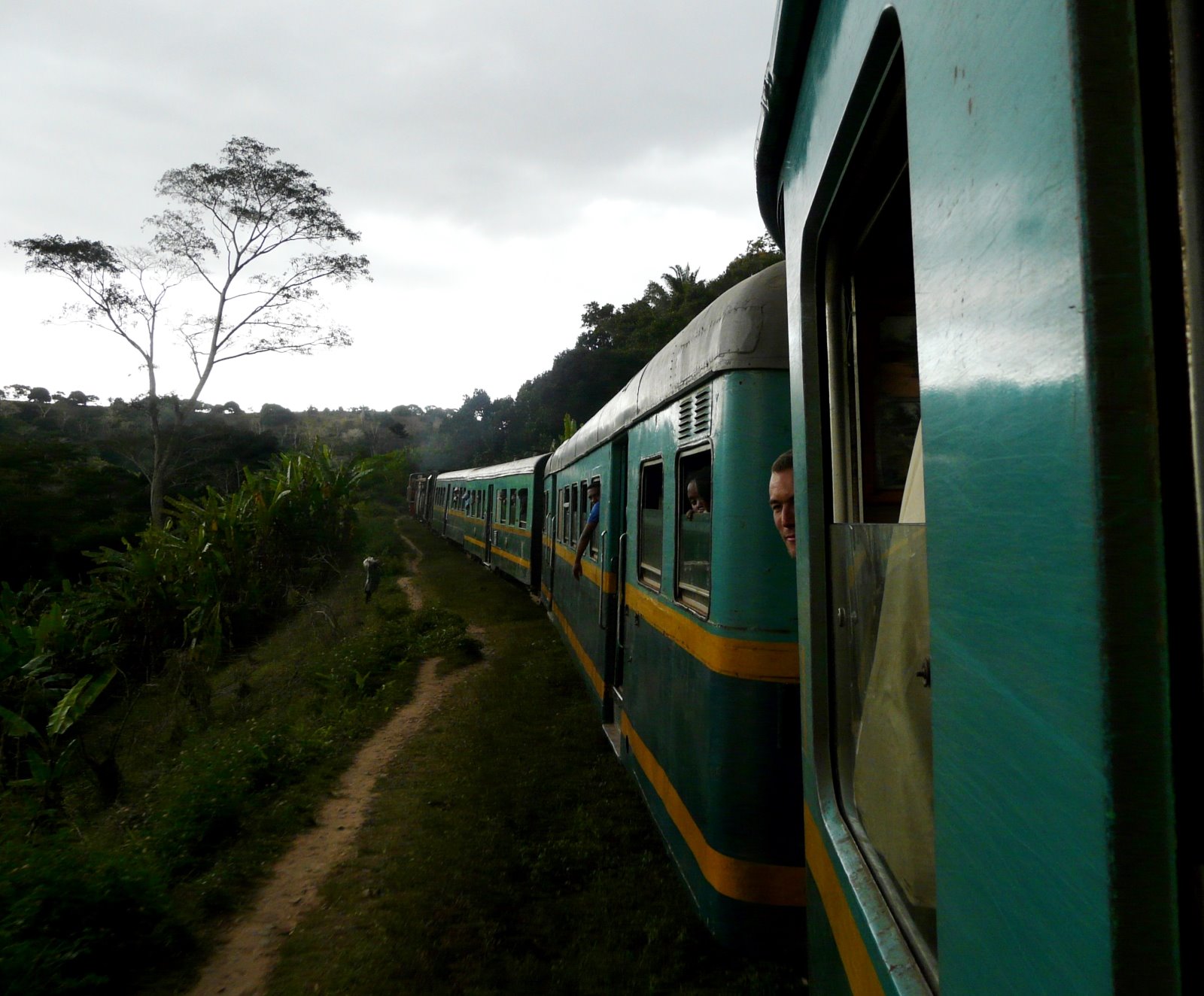
On the train On the Fianarantsoa-Côte Est railway, its tracks dating back to 1893
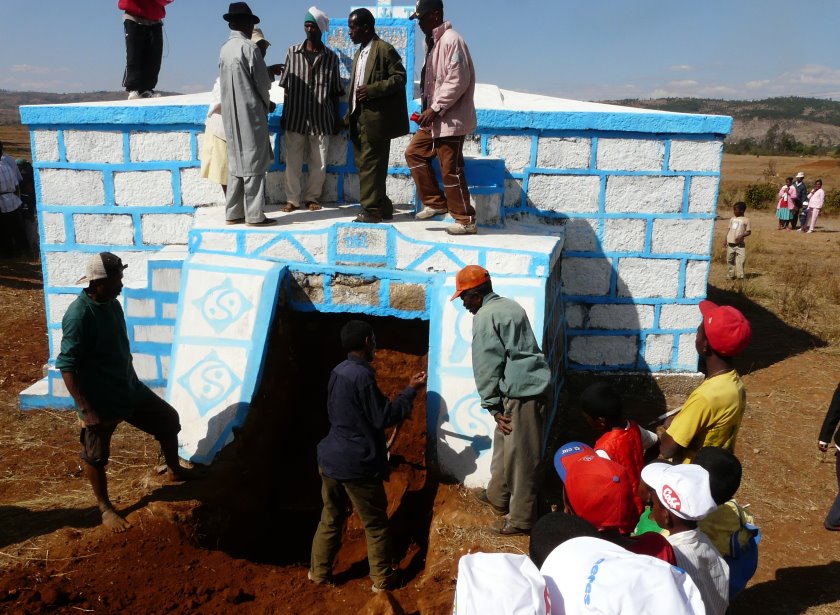
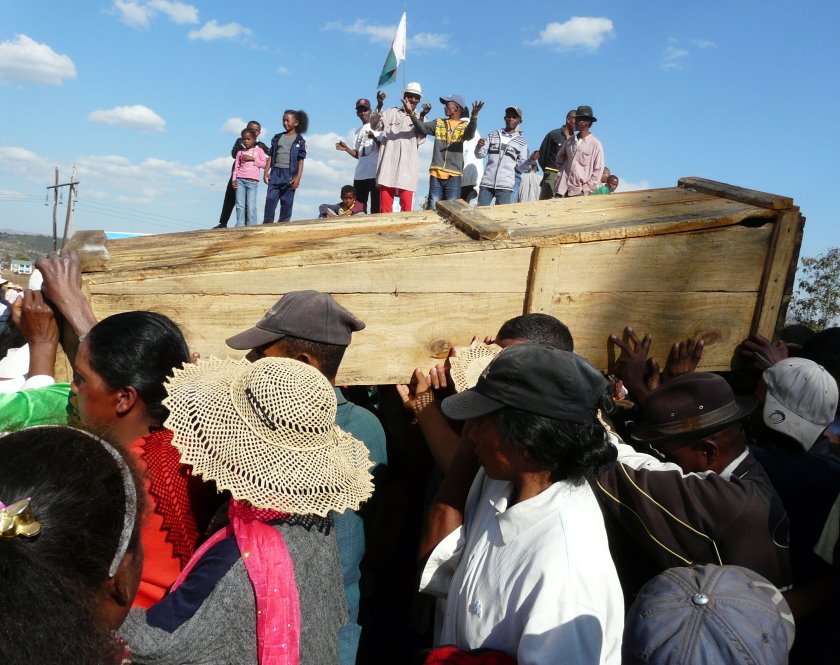
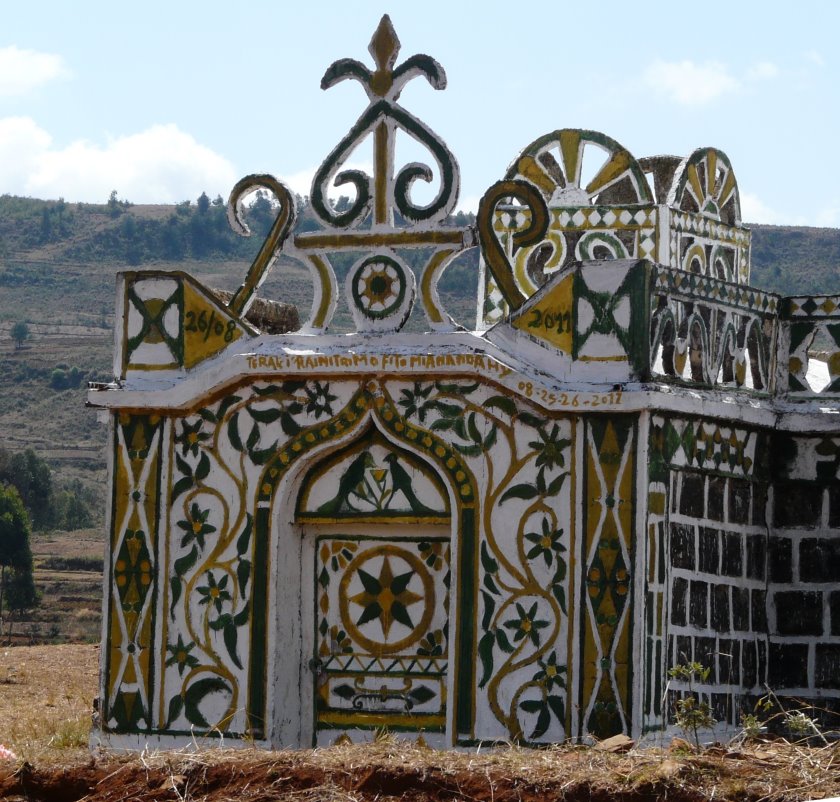
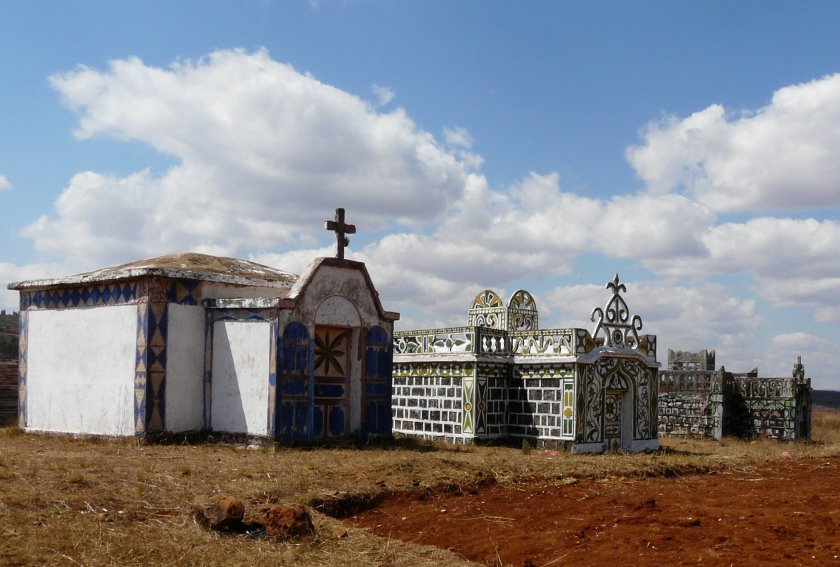
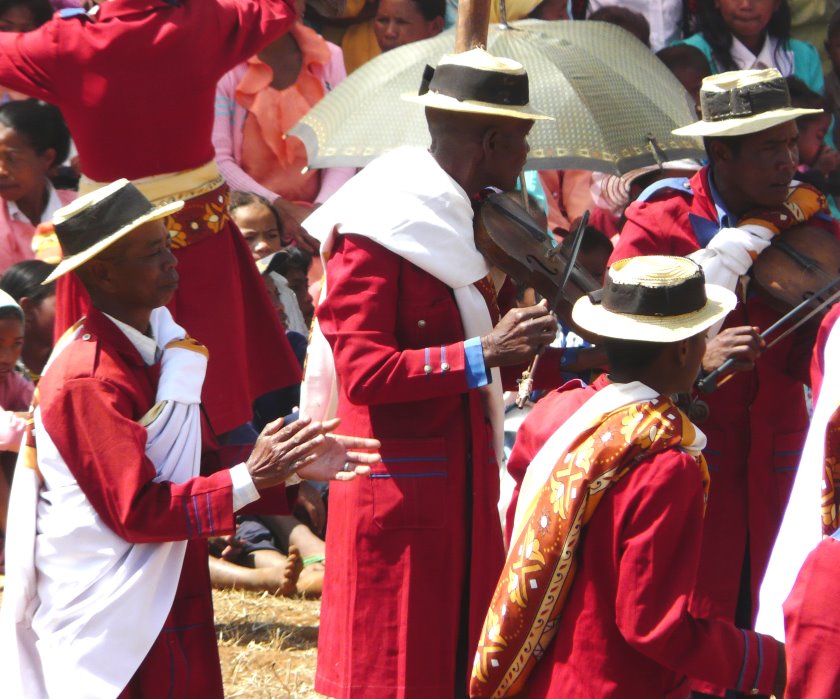 Above: A famadihana, or a re-burial, a difficult-to-find ceremony which the author located in Antsirabe.
Above: A famadihana, or a re-burial, a difficult-to-find ceremony which the author located in Antsirabe.
In the morning, we hit Route 7 again, blazing across the flat grasslands of the Horombe Plateau. The road climbed into the central highlands, through a landscape that seemed to fuse Toscana with Bali. Yellow brick houses with terracotta roofs crowned hills layered with rice paddies. Ochre paths slashed through a patchwork of tan and verdure fields. Plumes of smoke rose from stacks of baking bricks. Two men pushed their hand truck trolley up a hill; on the other side, two more rode theirs down. A stone marker on a dangerous curve bore a skull and the warning, ‘Attencion! Mort!’
In the afternoon, we reached Fianarantsoa. Founded in 1830, the university town had a wealth of renovated buildings. Its most memorable structure, for me, was its vaguely Bavarian train station, where we embarked on the Fianarantsoa-Côte Est (FCE) Railway. Between 1926 and 1936, the French forced the Malagasy to build the line to the Indian Ocean—across 101 miles of mountains and jungle. Traversing 67 bridges and passing through 48 tunnels, it is said to be one of the steepest rail journeys in the world. Adding to its thrill was the equipment. FCE’s one train, built in 1981, was a hand-me-down from some European railway. It travelled on rails made in 1893. Vy, who’d taken this journey before, looked nervous. Yet, as our battered yellow and green carriage rolled out of Fianara, I felt presidential. Kids ran along side us. Cars honked. Farmers waved.
More excitement greeted us when we pulled into the next station. Young women appeared beneath our window, their heads propping up baskets of fried bread, oranges, bananas, custard apples, and hard-boiled eggs. Vendors offered a trinity of peppercorns—black, pink and green. As we chugged though the forest, the cabin filled with scents of eucalyptus, ginger, cloves, basil-like clidenia, and jasmine-sweet coffee blossoms. Branches slapped the train’s flanks. I worried that a vine might reach through an open window and snatch a baby.
At every station, the train disgorged and ingested passengers and cargo. No stop took less than 45 minutes. And there were 18 stops. We reached the end of the line—the seaside town of Manakara—at around 7 p.m., 11 hours after leaving Fianarantsoa. Our wheelman, Parson, was waiting for us. If I did it over, I would have had him meet us at a station halfway to the coast. In any case, it was good to be masters of our own transport again. It was also good to be heading back into nature.
After getting some sleep, we drove inland to Ranomafana National Park, a mountainous rainforest stretching over 160 square miles. It was drizzling as we headed into the woods. The 14 ft of annual rain certainly had made things grow. The foliage was so lush you couldn’t see more than 12 ft ahead. Bamboo shoots flew at us like kendo warriors. The moss was deeper than the shag carpet in Elvis’s Jungle Room.
Our stocky guide, Rafidison-Jean Emilien, got a cellphone call from one of his trackers, beckoning us to a distant section of the forest. We set off through the mud. Soon we had a bead on a pair of Milne-Edwards sifakas, covered with dark brown fur except where they seemed to have sat on some white paint. Though pregnant, the female leaped 15 ft or more to another tree, twisting her body 180 degrees in mid-air. The male did the same. It was like watching Peter Martins and Heather Watts doing grands jetés. We tried to keep up with the sifakas, slogging through the muck and falling on our asses. I must have been amusing to the male. He slid down a tree to study me. I gazed back at his persimmon eyes, his delicate fingers, his shiny, leathery face trimmed with dark chocolate fluff. I could have stared at my sifaka soulmate for hours. But, after a few minutes, he grew bored with me and moved on.
Later, Eamon and I shared sandwiches with some guides who said lemurs could be polygamous or monogamous. ‘They have many partners,’ chuckled one guide. ‘Just like I love my wife. And my four girlfriends!’
Another guide observed that, like some lemurs, the Malagasy are furtive lovers. ‘You rarely see a couple showing affection in public. But they’re actually very amorous.’ Apparently, Madagascar is the world’s 18th fastest baby-maker. The country’s median age is just over 18.
***
Having made a three-day detour from Route 7, we headed back to the main road. Once again, we were in the Highlands, where the Betsileo and Merina people “turned the bones” of their ancestors. But finding a re-burial—a famadihana—was tricky. Astrologers often waited till the last minute to advise a family on the most propitious date for the ceremony. There were no posted announcements. You had to ask around.
Hoping for the best, we pulled into Antsirabe. European settlers helped turn Antsirabe into Madagascar’s third largest city (population 226,000). Norwegian missionaries loved its alpine climate. The French dove into its hot springs—building the stately and still-operating Hôtel des Thermes. The French also introduced the rickshaw, known here as a pousse-pousse. Antsirabe is said to have well over a thousand pousse-pousse drivers, who haul everything from grannies to cinderblocks. I wondered what the life of a driver was like, so I struck up conversation with 22-year-old Bernard Rafanomezantsoa. He told me that he pulled his pousse-pousse from 6 a.m. till 9 p.m., that his father had pulled a pousse-pousse, that he wished he had a pair of shoes, and that ‘I pray to the Virgin Mary for another job.’ Just to see what his job was like, I told Bernard to get in his canopied jalopy and I pulled him down Grande Avenue. Bernard’s fellow drivers did double-takes, especially when I paid my passenger for the work-out. I was dripping sweat—hauling a pousse-pousse is not for pussies.
Bernard tipped me with some valuable information: the location of a famadihana! He pointed us to a field where a couple hundred people were gathered around a blue-and-white stone tomb that two families had built back in the 1960s. Men were digging at its base. Everyone quieted down as Gilles Rakoto, an elder family member in a green suit, climbed atop the tomb to speak. Respecting the kabary tradition, he told the crowd: ‘I apologize for taking the stage when there are so many distinguished officials and family members present.’ He gave elaborate thanks to God, adding, ‘I pray this political crisis will be over because the Malagasy people have always been brothers.’
A rag tag quartet of musicians launched into a kind of swinging beguine as the diggers went into the tomb. People crowded around the mortuary’s opening, waiting for their loved ones to arrive, as though they were at an airport. Several men hoisted the first pine coffin on their hands. When they set it down, a man poured a little Three Horse Beer on it and then took a swig himself. Without exposing the skeletons, families wrapped the old shroud in a new white one. Coffins and bone-filled raffia mats sailed above the crowd like missiles.
Amidst the gaiety, Guinieve Razafindratsimba, wept for her sister, Melanie, who’d died of bronchitis in 1998, when she was 25.
‘Melanie’s children are here.’ Guinieve, 67, told me. ‘It’s a party, but it still makes me sad.’
It had been an unforgettable spectacle. And yet … I wasn’t satisfied. I still hadn’t seen a hiragasy—the quintessential Malagasy performance. Descended from royal court entertainers and later used by the French as town-criers, the hiragasy performers were now influential in political campaigns. But their main gigs were famadihanas.
Our eternally patient guide and driver, Vy and Parson, agreed to go on another goose-chase in the countryside. We’d bounced around on cratered roads for an hour, querying strangers, before we found a grassy hollow ringed with people under yellow, pink and blue parasols. In the centre of this natural amphitheatre were about two dozen hiragasy performers, ranging in age from 12 to 70 years. The men wore straw boaters, patterned sashes and long coats modelled after nineteenth-century French military uniforms. Women wore satin and chiffon gowns in the style of the imperial court.
Competing today were two troupes—Tarika Anosiarivo and Tarika Ambatoharana. Anosiarivo’s performers, dressed in forest green, went first. Fiddlers played a bluegrassy number as their cast-mates circled in front of the audience, singing and gesturing in unison. They warned their audience about city slickers who cruised through the country in their cars: ‘Once girls see these boys, they run after them. And you boys, before you take a wife, be careful of those girls from the cities, in their mini-skirts. If you marry her, you’ll be the housemaid.’
They turned to religion. ‘The preacher talks about what’s bad for you,’ they all sang. ‘But when he’s finished preaching, he’s looking at all the girls in the church!’
It was one of the best shows I’d ever seen—folkloric but topical, and full of more homegrown energy than a season of Glee. And, despite the shade each troupe threw at the other, they never veered into overt insult.
I wanted to stay to see which troupe collected the most money. But we had a date with another entertainer in Tana.
Eighteen years earlier, in New York, I’d heard a four-person band from Madagascar called Tarika Sammy. They played bizarre instruments like the valiha (tube harp) and the marovany (box zither). Most riveting was their lithe, gamine singer, Hanitra Rasoanalvo. After the show, I went out to dinner with Hanitra, her bandmates, and the legendary musicologist Alan Lomax.
Hanitra went on to become Madagascar’s most successful musical export and an important voice in the country’s cultural and political dialogue. In 2002, she opened a hilltop compound in Tana called Antshow, a combination performance space, recording studio, restaurant, and boutique hotel. Now, three weeks after leaving the capital, we pulled up to Hanitra’s door.
With her soaring cheekbones and fiercely chopped locks, she still looked hot. A make-up artist was getting her ready for that evening’s performance art piece, in which Hanitra and Antshow artists-in-residence would dramatize the destruction of Madagascar’s environment.
‘It’s getting worse and worse,’ she said over coffee. ‘There is the so-called Ministry of the Environment. But there are almost no regulations. People are doing whatever they want.’
This was not artistic embellishment. The 2009 military coup had set off a panic that saw unpaid park rangers and gun-shy conservationists leave the national preserves largely unguarded. According to environmental activists, armed gangs, bankrolled by foreign timber traders, began to plunder the forests, paying off officials and hiring impoverished locals to fell precious hardwoods. The “transitional” government even lifted the ban on exporting rosewood, whose pink tint and dense grain make it a favourite of Chinese furniture-makers who mimic Ming antiques.
Hanitra contended that villagers, who received the financial sawdust, ‘don’t want to cut the rosewood. But they say, ‘We need to eat.’
‘We used to call the forest the land of the ancestors,’ she went on. ‘The fadys helped preserve species. When the Christians came, they said you are not supposed to believe in these taboos.’
***
About 90 per cent of Madagascar’s original forest has disappeared since man’s arrival thanks to logging, charcoal production, and slash-and-burn agriculture (known as tavy). Worldwide outcry shamed many shipping companies into refusing to transport hardwood. The crushing loss of tourist income due to the 2009–13 political crisis made some locals appreciate the importance of protecting their natural attractions. President Hery Rajaonarimampianina has promised to fight the “rosewood mafia” but conservationists doubt his determination.
The day after seeing Hanitra, we headed to one of the most popular national parks, Andasibe-Mantadia, about two-and-a-half hours east of Tana. There, we ventured into the forest, searching for the park’s star—the indri. A recent study reported that 94 of Madagascar’s 103 lemur species are now at risk of extinction because of habitat destruction and poaching. Some people come to Madagascar just to hear the song of indri, a creature that cannot survive in captivity. Some visitors never find an indri or, if they do, lose patience waiting for its song.
Our guide, Patrice Rabearisoa, led us to a grove where, high above, an entire indri family was lounging around. We watched as the green-eyed mother licked her black and white fur. When she moved to a different branch, one of her young tried to follow. Just when it looked like the infant was about to fall, she grabbed it.
The indris have long been sacred to the Malagasy. Forest tribes saw themselves in these long-legged, upright, sunbathing creatures whose complex vocabulary included public assembly roars, civil defence honks and courtship kisses. What’s more, the indri is monogamous. Okay, maybe that’s where the comparison breaks down. Anyway, long before Darwin, the Malagasy believed they were related to these prosimians. The Malagasy name for them is babakoto, translated as ‘father of a little boy’ or ‘ancestor’.
All this ancestor worship made me laugh when I first got to Madagascar. I could think of a few uncles whose dinner antics didn’t exactly inspire my faith. Never mind all the abusive Moms and deadbeat Dads. But which of us—even the atheists—don’t commune with our departed parents, even if we hate them? Think of the offerings we make to our own ombiasas (be they priests, rabbis or shrinks)—trying to make peace with our creators. If they’re lingering somewhere, you have to figure they’ll have some advice, as they did in life, even if we didn’t want it then.
The indri Mom suddenly called out—whooooeeeh! Her song gave me a chill. It was as though I’d heard my own late mother shouting up the stairs of our house, telling me to get into the car. Walking back through the forest, I thought of all those family road trips. I felt grateful, as a future ancestor, that I’d reached Madagascar with my son, who one day will surely tell this story better than I have. •
continued below
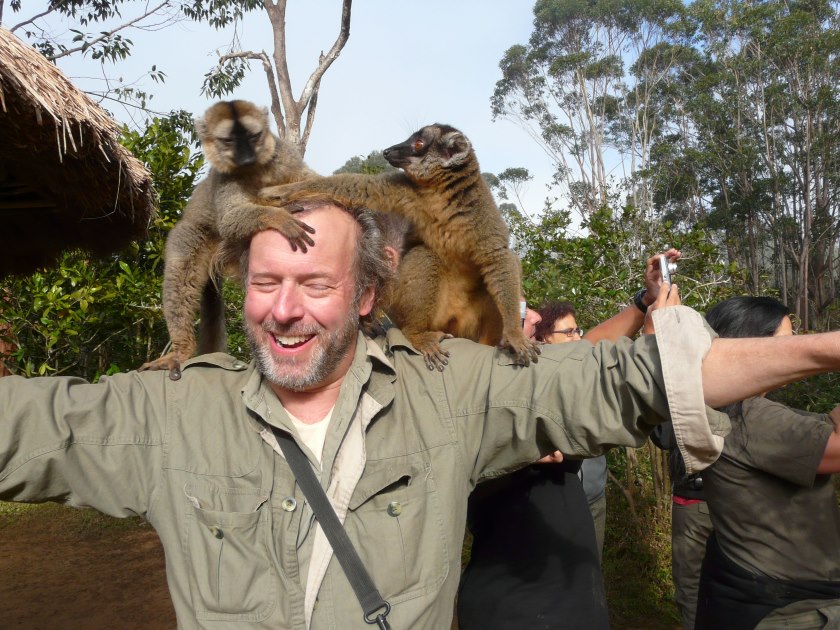
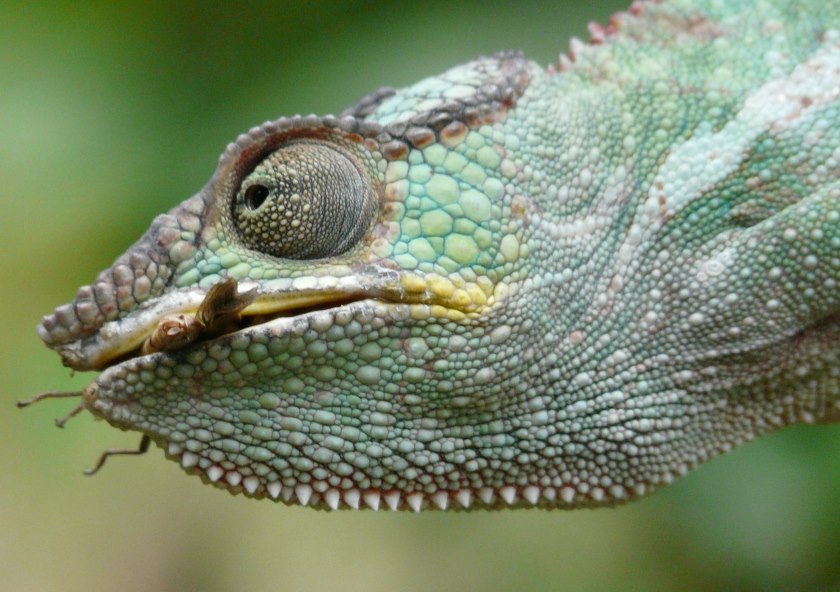
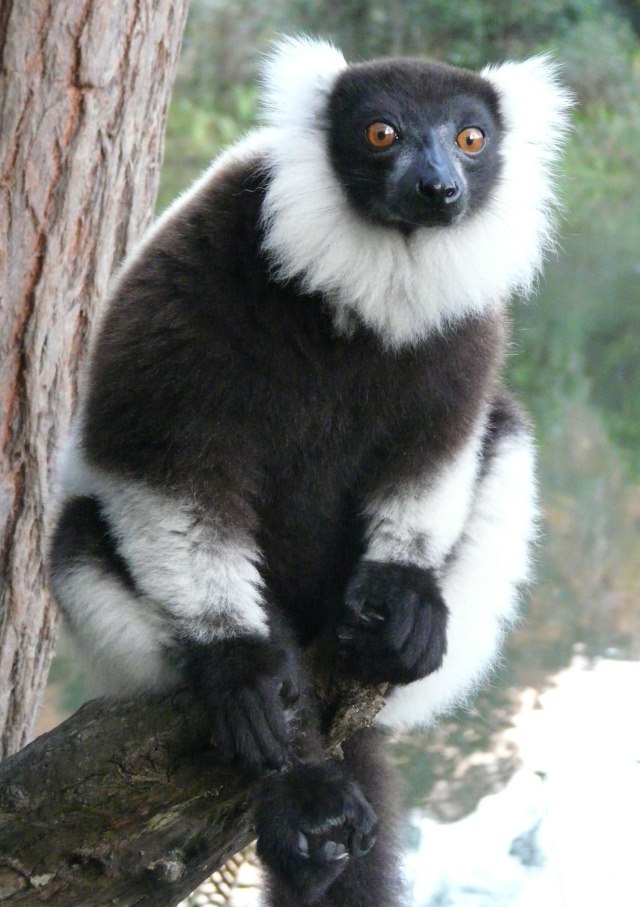
Top: Common brown lemurs frisk the author. Centre: Almost half the world’s chameleon species live in Madagascar. Above: The black-and-white ruffed lemur, one of about 100 varieties.
Madagascar notes
Related articles hand-picked by our editors
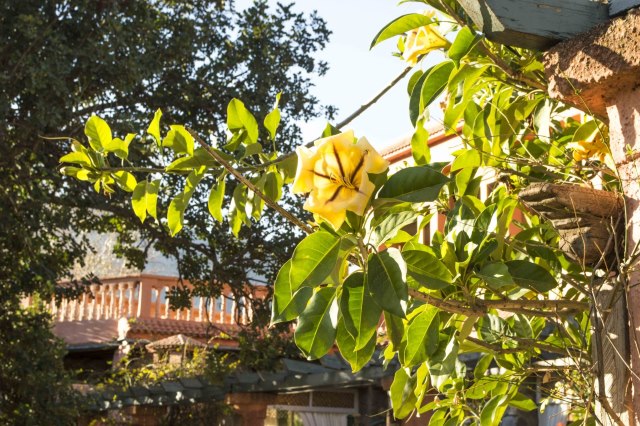
New meets old in Morocco
In our spring travel series, Stanley Moss looks at locations that successfully blend new and old, with his first stops treasured finds in the Atlas Mountains, Marrakech and Essaouira
photographed by Paula Sweet
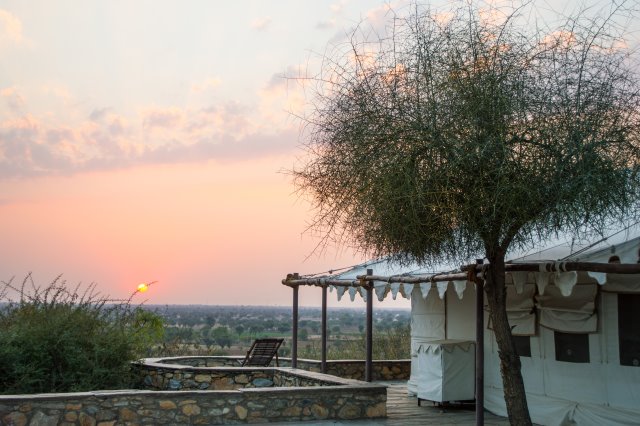
Green India
Stanley Moss discovers that ecotourism need not be the ego-driven affair that it has become in some circles. Keeping it pure, he visits Chhatra Sagar, Sarai at Toria and Samode Safari Village in India
photographed by Paula Sweet
from issue 35 of Lucire
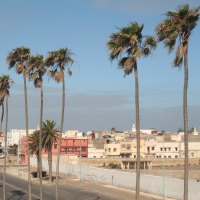 Where variety is always the spice of life
Where variety is always the spice of life
In Marrakech and along its Atlantic coast, Morocco is always in fashion by Elyse Glickman
photographed by the author
Advertisement
Copyright ©1997–2022 by JY&A Media, part of Jack Yan & Associates. All rights reserved. JY&A terms and conditions and privacy policy apply to viewing this site. All prices in US dollars except where indicated. Contact us here.